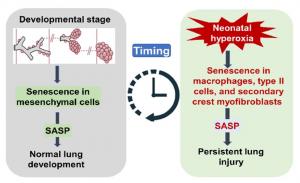
Chinese Medical Journal Pulmonary and Critical Care Medicine Study Uncovers the Role of Cellular Aging in Lung Diseases
A new study elucidates the molecular mechanism of senescence that can be targeted therapeutically to prevent lung diseases
BEIJING, CHINA, August 26, 2024 /EINPresswire.com/ -- The process of cellular aging, termed senescence, plays a crucial role in normal lung development and healing. However, suboptimal senescence can lead to diseases like bronchopulmonary dysplasia in infants, characterized by abnormal lung tissue. In this review, researchers provide a detailed account of the molecular pathways that are involved in senescence of early lung tissue and pathogenesis of lung diseases. They provide a comprehensive description of therapies that can control senescence and prevent lung diseases.Human cells are not capable of replicating indefinitely. Due to a range of factors, cells can stop dividing and accumulate as aging tissue in the human body. This process is known as senescence. Senescence can happen for various reasons, including normal cellular processes that are part of aging, diseases, and exposure to radiation or cigarette smoke.
A review conducted by Dr. Phyllis Dennery and Dr. Hongwei Yao from Brown University, provides a comprehensive account of the role of senescence in normal lung development and the potential therapeutic strategies for preventing lung diseases. It was published online on March 2, 2024 in the Chinese Medical Journal Pulmonary and Critical Care Medicine.
Optimal senescence is most important when the lung’s air sacs are being formed, a phase known simply as the saccular stage of lung development. The number of senescence cells in lung tissue is highest at the saccular stage and progressively decreases. But what happens when it does not decrease? Deviations from the optimal number of senescence cells at different stages of lung development leads to several permanent defects in the lung tissue. For example, an abnormally high oxygen concentration, or hyperoxia, in the lung tissue after the saccular stage prevents the normal reduction in senescence cells, which can cause bronchopulmonary dysplasia in infants.
“Reducing the number of senescent cells during the saccular stage disrupts normal lung development, suggesting that senescence is a programmed process for lung development. Interestingly, neonatal hyperoxia interrupts the normal reduction in developmental senescence by causing a transient increase during the alveolar stage. This leads to alveolar and vascular simplification, characteristics of bronchopulmonary dysplasia, a chronic lung disease in premature infants,” explains Dr. Yao.
The study highlights several molecular mechanisms that influence senescence in lung tissue. It highlights potential therapies targeting these mechanisms that can help clinicians artificially control senescence to ensure the development of healthy lung tissue or reduce injury in rapidly aging tissue. For example, a class of drugs called ‘senolytics’ kill senescent cells by activating their internal mechanism of programmed cell death. Senolytic drugs such as quercetin and dasatinib have already been tested on patients with diseases such as idiopathic pulmonary fibrosis, a condition that is intricately connected with abnormal senescence. However, more clinical trials are needed to determine their efficacy and safety. Another class of drugs called ‘senomorphics ‘or ‘senostatics’ reduce senescence without actively killing senescent cells. However, these drugs may have detrimental effects on non-senescent or healthy cells.
Even with the right drugs for manipulating senescence, the utility of these drugs will depend on clinicians knowing when to facilitate or suppress senescence. “Senescent cells not only play important roles in the pathogenesis of chronic lung diseases in neonates including bronchopulmonary dysplasia, but also contribute to normal lung development. Therefore, for the treatment of bronchopulmonary dysplasia, it may be critical to maintain normal developmental senescence while reducing senescent cells resulting from injury,” explains Dr. Yao.
In addition, not all senescent cells within early lung tissue are the same. The numerous types of senescent cells differ in terms of morphology and other crucial characteristics. Therefore, identifying the spatial distribution of various senescence cells may also be crucial in developing targeted therapies for bronchopulmonary dysplasia.
By identifying the key molecular mechanism underlying senescence, the study may guide the development of novel therapeutic strategies for controlling senescence in infants and adults. Furthermore, as the study indicates, effective therapies for preventing bronchopulmonary dysplasia may reduce the risk of developing chronic obstructive pulmonary disease, asthma, and pulmonary hypertension in later life.
Dr. Yao concludes, “Accumulating evidence suggests early origins of adult chronic lung diseases, such as chronic obstructive pulmonary disease and asthma. However, further studies are warranted to investigate whether neonatal lung senescence in bronchopulmonary dysplasia contributes to the development of these pulmonary diseases in adulthood.”
***
Reference
Title of original paper: Emerging role of cellular senescence in normal lung development and perinatal lung injury
Journal: Chinese Medical Journal Pulmonary and Critical Care Medicine
DOI: https://doi.org/10.1016/j.pccm.2024.01.001
Peifang Wei
Chinese Medical Journal Pulmonary and Critical Care Medicine
+86 13810923769
Weipeifang@cma.org.cn
Distribution channels: Culture, Society & Lifestyle, Education, Healthcare & Pharmaceuticals Industry, Science, World & Regional
Legal Disclaimer:
EIN Presswire provides this news content "as is" without warranty of any kind. We do not accept any responsibility or liability for the accuracy, content, images, videos, licenses, completeness, legality, or reliability of the information contained in this article. If you have any complaints or copyright issues related to this article, kindly contact the author above.
Submit your press release
